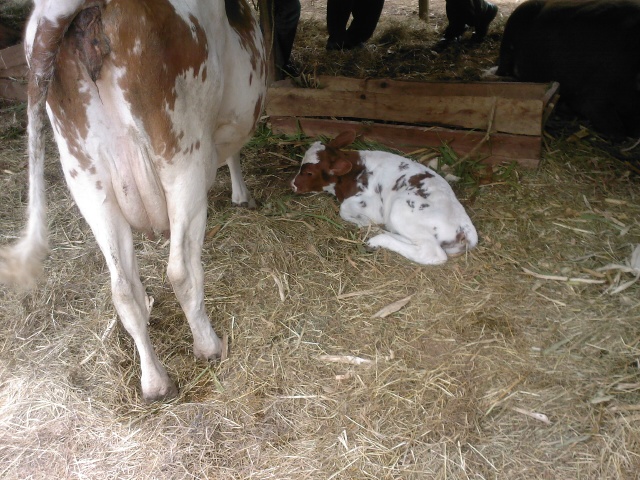Good Calf Rearing

Good calf rearing is an important undertaking because the productivity of cattle is mainly influenced by the care it receives when young. Young stocks form the foundation of replacement stock, can be used to expand dairy stock and/or can be sold to generate income for the farmer.
To achieve all these, the young stock should be fast growing, healthy, not costly to raise and have reduced mortality.
Young stocks includes - calves (birth to weaning 2-4 weeks), weaners (from weaning to 12 months) and heifers (from 12 months to lactation)
Calf Handling at Birth
An expectant cow should be brought to the calving place 2-3 days before the expected calving date. This is facilitated by a good record keeping. A cow can give birth in two places
-
Outdoor (maternity paddock) – it should have good pastures, plenty of water, near the farm for closer supervision, clean and free from injurious objects i.e. sharp objects, stones etc.
-
Indoor (maternity pen) – it should be thoroughly cleaned before bringing in the expectant cow, have adequate space to allow free turning of the cow, and be lined with warm and dry bedding materials.
Once the cow calves down allow it to thoroughly lick the calf to clear nostrils off mucus. Licking also stimulates thoracic muscles hence the calf can start breathing. If by any reason the cow is not able to lick the calf, assistance to open the nostrils should be given. Cut the umbilical cord with disinfected clean razor. Apply copper sulphate or iodine to protect the naval area from infection. Allow the calf to suckle colostrum. Ensure that the cow expels the placenta and dispose it off safely.
Calf Feeding
Ensure that the calf gets colostrum (first milk) within the first 72 hours. During this time the calf’s gut is highly permeable to intact macromolecules. To ensure that the calf gets as much colostrum as possible leave the calf to stay with the mother for one week. Colostrum usually changes very fast to normal milk. This is necessary as:
-
Colostrum contains antibodies (gamma immunoglobins) which impacts calf passive immunity. Within the 72 hours the antibodies will not be digested as the level of proteolytic enzyme in the gut is still very low.
-
Colostrum is very nutritious (proteins, minerals and vitamin A) and this gives the calf a good start.
-
It is highly digestible hence rapid utilization.
-
Colostrum is a laxative and it helps in removal of the meconium (first feaces) which if not removed causes constipation.
The surplus colostrum can be kept in a freezer for future us in case of orphaned calves.
If the calf does not get colostrum from its mother after birth then the following should be done:
-
Use stored colostrum (frozen colostrum). Warm it to body temperature first.
-
Use colostrum from a contemporary dam (from in the farm or neighborhood farm)
-
Prepare artificial colostrum using: -
-
Whole milk (0.6 litre)
-
Whipped egg (source of vitamin A)
-
Castor oil (1/2 teaspoonful)- as laxative
-
Clean warm water(0.3 liter as dilutant)
Feed the calf three times a day.
2nd to 4th Week
At this stage the calf depends majorly on fluids. The calf may be fed on:
-
Whole milk – obtained from the dam through suckling directly or artificially fed a 10% of the calf’s body weight.
-
Milk products – e.g. skimmed milk, skimmed powder (add some fat to skimmed products to boost energy level), whey.
-
Milk replacers/substitutes – commercial products which more or less resemble milk but are cheaper. Milk replacer should have a good source of energy, proteins, not too dilute and made according to the manufacturer’s specification.
5th Week to Weaning
At this stage the calf should be fed with a combination of milk and solid feed. Concentrate (calf pellets) are beneficial at this time. The calf should be given a starter diet which should be:-
-
High in energy (75% Total Digestible Nutrients) and proteins (18 – 20%)
-
Rich in minerals and vitamins. These can be fortified with broad spectrum antibiotics for faster growth.
-
Palatable and acceptable to the calves
-
Have relatively low crude fiber because the rumeno-retriculum is still not well developed.
Calf Weaning
It entails total withdraw of liquid feed from a calf so that it entirely depends on solid feeds (roughages and concentrates)
Either of the following criteria may be followed.
-
Age – here early weaning system or late weaning system may be employed by the farmer. In early weaning system the calf is weaned from the age of between 5 to 12 weeks and it requires better organized feeding program involving more milk and early concentrate introduction. Late weaning system calves are weaned when between 3 and 4 months old.
-
Size – done when the calf doubles their birth weight.
-
Body condition – sickling, weak, and very young calves are given more time to consume milk before they are weaned.
-
Feed intake – calves at weaning will be taking 2kg or more solid feed particularly roughage.
Conclusion
It is cheaper to raise young stock in the farm for the purposes of replacing the existing stock or expanding the herd than purchasing from the neighboring farm or market. Because the productivity of an animal has a direct bearing on the care it was given when young, it is important that farmers put emphasis on caring for the young stock. Still further a well-cared for animal fetches more price than the one neglected. The farmers’ sole interest in any enterprise they engage in should be to reap in much income; good caring for young stock realizes this and therefore worth to venture into.

